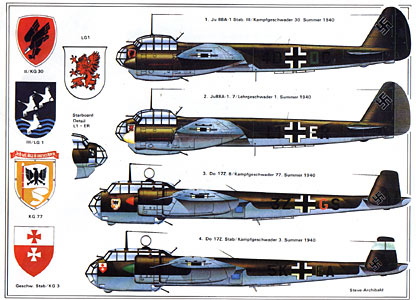

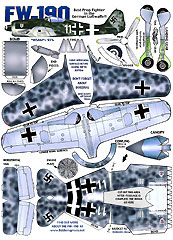
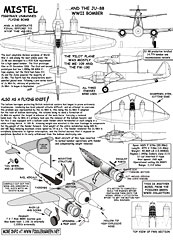
Mistel-WWII Unmanned Flying Bomb
Used aircraft go to the bomb factory!
Using surplus JU-88 Night Fighters or bombers as makeshift guided missiles was just one of the desperate schemes attempted by the Luftwafe during the final year of the war.
At the end of WWII, the JU-88 was a favorite aircraft to conversion to unmanned flying bomb configuration to serve as the lower half of a Mistel composite.
Some retained their noses for training and others had a massive warhead attached as shown here.
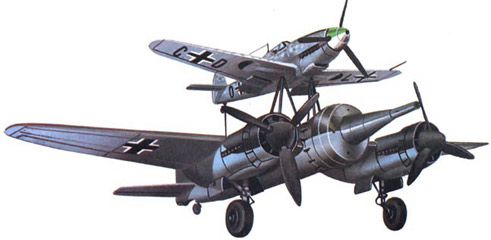
Thanks for asking me to do the buildup. Hope you like it, I did. Anthony"
Wow. Looks great. Where did you FIND this thing? Kell Black
Looks great. Yet another one to build., Toby
ooooooooohhhhhhhh! nice! Jim C
Magnificent!" Tim G
Wonderful work on the Mistel! I love every release you guys and ladies make :) Roy C.
.jpg)
Mistel-WWII Unmanned Flying Bomb
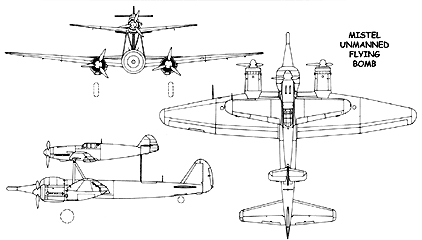
American and British work on aerial torpedoes revived somewhat
in World War II. In 1940, Miles Aircraft of the UK proposed an
aerial torpedo they called the "Hoop-la", and constructed
a mockup. The Hoop-la was a neat little high-wing aircraft built
around a 450 kilogram (1,000 pound) bomb, featuring a Gipsy Major
air-cooled four-cylinder inline engine, a wingspan of 4.3 meters
(14 feet), and an estimated speed of over 480 KPH (300 MPH).
While the accuracy of the Hoop-la would have undoubtedly have been poor, Miles Aircraft felt that it could hit a city. Swarms of Hoop-las coming in at low altitude at night would have given German air defenses a very hard time.
The British Ministry of Aircraft Production was not interested in the Hoop-la, apparently because there was still some squeamishness about general attacks on cities. If there was such squeamishness, it didn't last long, since general military bombing of cities at night became RAF Bomber Command policy in a short time, but the Hoop-la remained dead.
The Germans developed a series of aerial torpedoes, derived from studies performed in the 1930s by the Soviet Union into "composite" aircraft, in which big lumbering Red bombers carried fighters perched on top or dangling from the wings.
In 1941, the German Air Ministry (ReichluftMinisterium or RLM) began to investigate composite aircraft, and a suggestion was made that the scheme could be used to allow a fighter to guide an unmanned war-weary Junkers Ju-88 bomber packed with explosives to a target. The idea wasn't popular, but then experiments using a piggyback aircraft to tow a glider demonstrated the feasibility of composite aircraft, and interest in the possibility of using a piggyback fighter to direct a flying bomb aircraft increased.
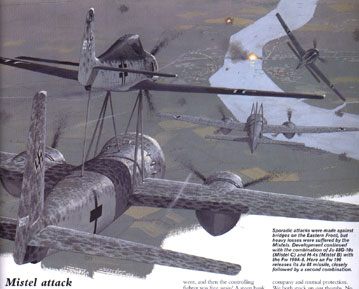
The RLM authorized a development project code named BEETHOVEN to build such a weapon, and the result was the "Mistel (Mistletoe)" composite flying bomb, with the name apparently derived from the fact that Mistletoe is a parasitic plant. The first Mistel flew in July 1943, and featured a Messerschmitt Bf-109E fighter fitted on a set of struts to the top of an unmanned, explosive-packed Ju-88A bomber.
The piggyback fighter was wired to the bomber's throttles and flight controls. The fighter pilot took the composite into the air, flew to the target area, flew straight at the target, and then released his fighter from the bomber. The bomber flew into the target on autopilot. Although some sources mention that a few of the bombers were radio controlled, it doesn't seem to have been general practice if it was done at all.
New Mistel versions were devised, using a Focke-Wulf Fw-190A fighter on top of a Ju-88G or Ju-88A. The operational version featured a Ju-88A-4 with the conventional nose and crew cabin removed, and a huge 3.5 kilogram (7,720 pound) hollow-charge warhead with a long nose probe. Tests demonstrated that the Mistel's warhead could penetrate almost any thickness of reinforced concrete, and also made short work of a old French battleship used as a target.
The Luftwaffe high command became very enthusiastic about the Mistel and planned to use them in a heavy coordinated blow code named OPERATION EISENHAMMER (IRON HAMMER). The Mistel went into operation in June 1944, and a few were used against Allied ships at the end of the month. Surprisingly, none of the Mistel hits actually sank a ship.
There were a number of confusing minor variants of the Mistel, with such features as reinforced landing gear for the Ju-88 to deal with the higher take-off weight, and Fw-190As with overawing tanks to provide greater range. A few Mistel's were actually built with piloted Ju-88s for long-range "pathfinder" missions, where the Fw-190A was simply taken along to provide a fighter escort.
Though over 250 Mistel's were built, including some based on new-production Ju-88s, OPERATION EISENHAMMER never took place. The Mistel's were expended in piecemeal attacks, mostly against bridges in hopes of stemming the flood of Allied forces towards Germany. Under unceasing pressure, the Luftwaffe was never able to accumulate enough Mistel's to make the big blow.
Of course, the Germans also developed a jet-powered aerial torpedo that actually saw widespread use, the "Fi-103" or "V-1" flying bomb.
The Germans considered various other Mistel configurations, such as jet version, based on the Messerschmitt Me-262 jet fighter. This involved a piloted Me-262 with a glass nose to accommodate a bombardier lying on his stomach, propped on top of a pilotless Me-262 with a warhead nose. The entire contraption was to take off on a trolley that was discarded after take-off.
The Blohm und Voss company also proposed another Mistel configuration, in which a Dornier Do-217 bomber carried an 8 meter (26 foot) long, bullet like, ramjet-powered missile perched on its back, while the missile carried a tiny piloted ramjet aircraft on its back in turn. The Do-217 would release the missile in a dive to allow operation of its ramjet engine. The pilot of the piggyback aircraft would fly the missile to its target, aim it at the impact point, ignite the aircraft's ramjet, and then release the missile and return home.
Mistletoe for Scapa Flow
1942:
Since the beginning of the conflict, the German high command was
confronted with a crucial problem. The Home Fleet, the all powerful
British war fleet anchored in Scapa Flow harbor was blocking access
to the Baltic Sea and the North Sea, causing the surface vessels
of the Kriegsmarine to adopt a prudent inactivity. The containment
of Scapa Flow became a priority since the beginning of the conflict.
There had been an intrepid incursion by Günther Prien's U-Boot
in the night of October 13-14 1939 which gave a boost to German
moral, but this spectacular action did not resolve the problem.
As for attacking Scapa Flow by air, the Luftwaffe did not possess
any heavy bombers capable of such mission.
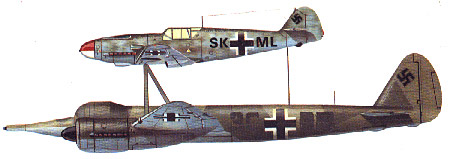
It is under those circumstances that Flugkapitän Siegfried Holzbauer, Junkers aircraft's chief test pilot thought about reviving the original, but already forgotten idea of Robert Mayo and to propose it to the Luftwaffe. In 1942, the Luftwaffe was indeed desperate to end the blockade of Scapa Flow, but how could it make an attack with a heavy destructive payload to a target that was so far remote? By providing a "one way" trip to worn out, pilotless Junkers Ju-88, loaded with a heavy charge of explosive. A fighter (Messerschmitt Bf-109 at first) mounted atop the Ju-88 in a fashion similar to the Mercury on the Maïa was assigned the mission to fly the ensemble to the target. It was then up to the pilot to guide the explosive loaded transporter into a crash trajectory on the target, and separate himself from the old Ju-88 about to end its final flight on the objective.
The RLM (Reichluftfahrtsministerium) was interested and Junkers experimented in the spring of 1943 with an elaborate Ju-88A - Messerschmitt Bf-109F arrangement, having first conducted some test with a DFS 230 glider. This system had required special techniques, particularly the electric flight controls that permitted the pilot to fly the transporter from his guiding fighter. The guiding fighter was mounted on steel struts and separation was obtained by mean of explosive bolts.
Takeoff was made on three engines, with the fighter pumping its
fuel from the JU-88 ensuring the return trip requirements
(this system did not work when the Focke-Wulf FW-190A was
used because its engine required a different fuel octane). The
flight was initially made at low altitude to avoid radar detection,
and at a distance of four kilometers from the objective, the "Father
and Son" climbed to 800 meters.
For the attack, the pilot established a 30 degrees dive at a speed
of 650 kilometers per hour. Once the target was well acquired
in the aiming sight, the Ju-88 auto-pilot was engaged by
mean of the electric control, and one of the jettisoning bolt
was exploded to place the fighter in a slight nose up attitude
in reference to the transporter. Then, the pilot exploded the
remaining bolts to free himself and return to base. This unconventional
weapon impressed the German High Command sufficiently to consider
its use on prime targets: Leningrad harbor, Gibraltar, and Scapa
Flow of course.
The Mistel in battle
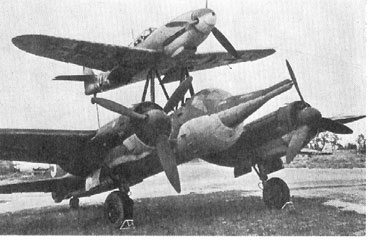 In May 1944, a unit of five Mistel was dispatched
to Denmark with Scapa Flow for objective. After D-day, the
composites retreated to Saint-Dizier (France) for a less ambitious
mission: the allied vessels anchored in the bay of the Seine River.
The attack occurred in the night of June 24th - 25th 1944. One
of the Mistel pilots spotted by a British Mosquito released his
payload. Having a cruise speed of barely 380 kilometers per hour,
a Mistel once sighted became an easy prey. The other four Mistel
successfully completed their mission and the fighters returned
to base without damage. The damages on the target did not reached
the level of destruction hoped for, but at last the procedure
had proven to be feasible.
In May 1944, a unit of five Mistel was dispatched
to Denmark with Scapa Flow for objective. After D-day, the
composites retreated to Saint-Dizier (France) for a less ambitious
mission: the allied vessels anchored in the bay of the Seine River.
The attack occurred in the night of June 24th - 25th 1944. One
of the Mistel pilots spotted by a British Mosquito released his
payload. Having a cruise speed of barely 380 kilometers per hour,
a Mistel once sighted became an easy prey. The other four Mistel
successfully completed their mission and the fighters returned
to base without damage. The damages on the target did not reached
the level of destruction hoped for, but at last the procedure
had proven to be feasible.
Once again, the Luftwaffe turned its sight towards Scapa Flow. Bad weather and clear nights not being ideal for attack by those slow aircraft; the mission date was rescheduled from day to day until November 11. The Tirpitz that was a permanent menace for the Home Fleet was sunk in a Norwegian Fjord. The British Fleet relieved by its disappearance was now able to disperse her forces. The strategic interest of an attack on Scapa Flow also disappeared at the same time that the vessels of the Royal Navy were beginning to leave the harbor.
In this time frame, the Anglo-American air superiority to the west was such, that it was no longer deemed viable to risk the Mistel on this theater of operations. Project "Eisenhammer" dating back from 1941 was once again considered. This project had been put on hold until the Luftwaffe had at its disposition a strategic adaptable airplane to transport the parasite.
It was a bold project: no less than one hundred Mistel, accompanied by an impressive armada (including Dornier 217K transporting flying bombs Fritz X), were to attack and destroy the three gigantic electric power-plants providing electricity to the Soviet Industry in Leningrad (North of Moscow) and in the Urals. One problem about this project that immediately became apparent to the pilots, was the fact that the fighters would never have the range capability to ensure the return flight. As a remedy, the pilots were provided with emergency rations for survival, some notions of the local language, and it was suggested that they land in territorial pockets still held by soldiers of the Reich.
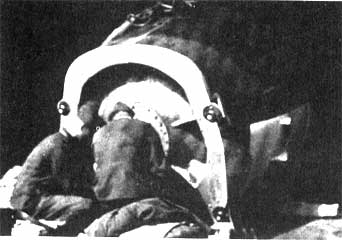
The assembly of such large number of Mistel would take a while. Meteorological conditions alone also delayed the operation for so long that the planned launching bases were either destroyed by the Anglo-American bombings, or they fell into Soviet hands. In the spring of 1945, it was no longer the time for ambitious operations, but the time to revert to more modest plans which would provide immediate results: slowing down the Soviet advance. On March 1st 1945, orders were given to the Kommodore of KG 200 to destroy the one hundred twenty bridges on the Oder, the Neisse, and the Vistule. It was a feasible operation for the aircraft, but too important a task considering the multitude of the objectives!
Much success was achieved, but the corps of engineer of the red
army would within a few hours built emergency pontoons bridges,
rendering the attack an exercise in futility. The last Mistel
attack occurred on April 26th 1945 on the Oder. Of the seven engaged
aircraft, only two FW 190 came back. The next day, II/KG 200 was
dissolved and its personnel were incorporated in the ground troops.
It was the "Twilight of the Gods".
A feared weapon
The first test of the "Father and Son" concept
occurred at the secret Luftwaffe base in Peenemüde on the
Baltic Sea, a site under close surveillance by allied observation
airplanes. In April 1944, a reconnaissance airplane had brought
back photos, depicting a very unconventional aircraft combination
identified as a Ju 88 carrying a Bf 109. This observation
corroborated with the story of a German prisoner of war claiming
to have witnessed such machine in flight.
This became a worrisome affair for the British, which were already
subjected to the pounding of the V1. They feared that those composite
aircraft would be used against their cities. Another question
pondered by the Allied strategists was how many of those aircraft
had been built. Well aware of the vulnerability of those machines,
the German did not leave them stationed at the same base for very
long, and consequently, the Allied reconnaissance airplanes were
reporting them here and there and everywhere. Fear was reinforced,
when due to either the inexperience of the pilot, or mechanical
malfunction, a Mistel crashed in Great Britain. It caused commotion,
but it also gave the technician a chance to satisfy their curiosity
by studying the machine at their leisure.
Because of the multiple problems
encountered by the Mistel units, the fear of this weapon
was never proved justified. In May of 1945, the Americans discovered
about fifty of those machines scattered around the Mersenburg
Junkers factories, but they were never the object of an in depth
study after the war. The Mistel had been a weapon of "circumstance"
but it would never received the interest of the many other projects
promptly recuperated by the Allied.
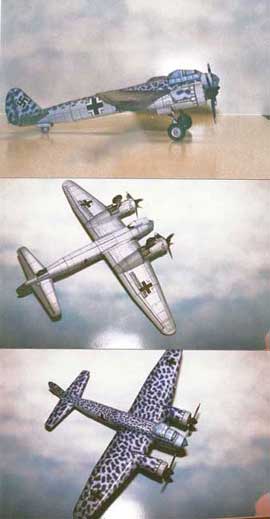 |
Chip, thought I would give a brief summary in building
the JU88. As you can see I made the piloted bomber version. All
the parts went together beautifully and I only encountered a
few areas that weren't exactly clear. These were minor of course. First was the little tab on the rear fuselage assembly. I wasn't sure whether to bend it back and let it bring the tail piece together. What I did do was leave it extended and let it fit inside the rudder. Don't know if that was right or not but it worked anyway. The only other thing that wasn't clear was the placement of the dive flaps. While there is a picture showing them somewhere near the engine nacelle, I couldn't really tell where to put them so I let the black stripe be part of the insignia. If there were some dots or something on the bottom of the wings, that would help. Now, as far as slight enhancements....As usual I used O-rings for the tires. I used round toothpicks for the landing gear strut reinforcements. On the props I carved spinners out of balsa and colored them with a black marker. I used an aluminum tubing piece thru each spinner to provide the shaft for the pin. I glued a piece of foam behind each engine disc for the pin to have reinforced support. I used flat toothpicks to give each prop support and dimension, sharpening the bottom of each to stick into the balsa spinner. Both props spin freely when air strikes them. I also glued a piece of foam inside the engine nacelle to provide a base for the landing gear strut. I tried cutting out the side fuselage aerials but, alas, my poor hands messed them up so I left these off. They really aren't that noticeable but they would have been neat attachments. However, I did attach the extra exhaust pipes. As I cut out each part, I used markers to color the edges to the degree that made sense so that the white would not show. My compliments to you and Kancho....a very, very nice model. I look forward to the revised ME-109 and I will finish it out! Your pal, James (03/03) |
JU 88 MISIELN
During 1943, the already unparalleled versatility of the Ju 88 was expanded still further by its adaptation as a missile/ pilotless aircraft with a large hollow-charge warhead guided to the vicinity of its target by a single-seat fighter temporarily attached to a superstructure above the fuselage. The idea of using time-expired JU- 88 airplanes in this fashion was allegedly that of a Junkers test pilot, Siegfried Holzbauer, who, undoubtedly influenced by the successful pre-war trials with the Short-Mayo S.20/S.21 composite, suggested this scheme to the RLM in 1941. The proposal was dismissed by the Technischen Anst as too unorthodox to have any practical application, but in 1942, Fritz Starner of the Demschen Forschungsinstilutfiir Segelflug initiated a series of Huckepack (Pick-a-back) trials with the primary aim of testing the feasibility of this arrangement for transport gliders.
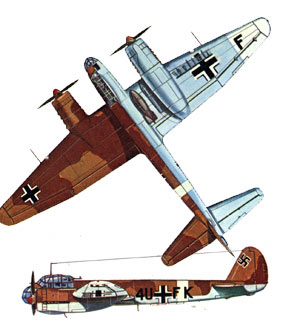
For these tests botli a Klemm KI 35 and a Focke-Wulf Fw 56 were mounted above a DFS 230 transport glider, and, eventually, a Bf 109E fighter was also tested as the upper Huckepack component. The success achieved prompted the revival of Holzbauer's proposals and, early in 1943, instructions from the Technische AmW to proceed with a prototype conversion.
The design of a suitable superstructure was undertaken by the DFS, drawing upon the Institute's earlier experience with Huckepack combinations, and this consisted of two steel-tube struts attached to the Ju 88 wing main spars on each side of the fuselage, the forward strut being vertical and the aft strut being inclined forward, these attaching at their tips to the arms of a V-strut connected to a fuselage mainframe, thus forming two inclined tripods. The apices of the tripods were intended to marry up with connections on the main spar of the fighter forming the upper component. A single strut supported the tail of the fighter, this being spring-opcrated and when disengaged by the pilot of the upper component sprung back to be caught by a yoke on the rear fuselage of the lower component. This yoke incorporated an electrical contact which released the main attachment points at the apices of the tripods immediately the tail-support strut sprang back, and also prevented this strut rebounding to strike the tail of the upper component.
The prototype conversion consisted of a Ju 88A-4 and a Messerschmitt Bf 109F, the lower component being referred to as a Mistel (Mistletoe), the connection between this parasitic evergreen and the lower component of the Huckepack combination being obvious. The combination was also referred to officially as the "Vater und Sohn" (Father and Son) after a popular German strip cartoon, but Mistel was to become a generic term for the lower component of all such combinations, irrespective of the type of aircraft involved, and when, in July 1943, instructions were given to Junkers to proceed with the conversion of 15 Ju 88A airframes for Mistel use, the weapon was allocated the code name Beethoven. Prototype trials proved successful, and the Beethoven program was transferred to Nordhausen where, during the spring of 1944, pilots of the Einsatz-Sfaffel of IV/KG 101 received conversion training from Junkers test pilots.
The initial model was known as the Mistel I and comprised a Ju 88A-4 and a Bf 109F-4. the first few conversions being completed as Misfel S 1 trainers, the "S" indicating Schulung (Training). All Misteln were initially flown and tested with the standard nose section,, the cockpit being stripped to its bare essentials and providing accommodation for a crew of two. The entire nose section could be detached by means of quick-release bolts and replaced by an 8,380-lb. hollow-charge warhead which used the same attachment points. Large hollow-charge warheads had been tested with considerable success against the obsolete French battleship I'Ocean during the later part of 1943, and other experiments were performed in which the warhead was tested against reinforced concrete, the one-ton steel core bursting through concrete some 60 ft. thick. The final warhead tests were performed at Peenembrale in April and May of 1944, and in the following month the Einsatz-Staffel of iV/KG 101 arrived at St. Dizier with Mistel Is to attack Allied invasion forces.
The Mistel 1 was basically similar to the original prototype conversion, apart from somewhat sturdier bracing struts, and two methods of operation were proposed. The first of these called for take-off and flight to the target area on the power of the lower component alone, the airscrew of the upper component being feathered and its pilot only starting the engine during the final phase of the approach to the target. The second method of operation was to employ the engines of both components from take-off, the latter being generally adopted, the upper component drawing fuel from the tanks of the lower component until the two parted company. When the objective was reached, the pilot of the upper component set the controls to approach the target in a shallow glide, and at the appropriate distance detached his aircraft and climbed away, the pilotless lower component continuing on its set course.
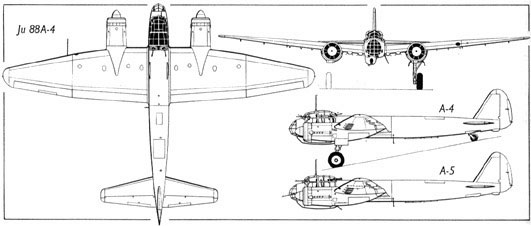
The Eimatz-Staffel of IV/KG 101, commanded by Hauptmann Horst Ruclat, had five Mistel s on strength when it arrived at St. Dizier. and performed its first operational sortie on the night of June 24, 1944 with one of these. This proved abortive as the lower component had to be released prematurely when a Mosquito night fighter suddenly appeared, Shortly afterwards, the unit's four remaining Misteln were used for a nocturnal attack on Allied shipping in the Seine Bay, this time escorted by Bf-109G fighters.
Flares were dropped and the attack pressed borne, but targets could not be observed owing to the smoke screen emitted by the target vessels. Reconnaissance undertaken on the following day revealed that all the Misteln had found their targets but none of the vessels hit had been sunk.
Despite the limited success that had attended these operations the potentialities of the Mistel were considered proven, and instructions were issued to the Leipzig-Mockau factory to adapt for the Beethoven program 75 Ju 88G-1 fighters awaiting repairs, the designated upper component being the Fw - WA-6 or F-8 the engines of both upper and lower component using 95 octane fuel. This combination received the designation Mistel 2, the training version being the S 2.
Considerable trouble was experienced with these early Mistel, and take-offs from rough runways proved extremely hazardous as shocks frequently burst the tires of the undercarriage. After losing a number of Misteln in take-off accidents resulting from burst tires, a jettisonable third main wheel was added beneath the fuselage of the Mistel 3 series.
On October 10, 1944, it had been agreed that available Misteln should he reserved for one decisive blow, and among several plans formulated was an attack on the British Fleet in Scapa Flow which was to take place in December 1944. For this operation some 60 Missions were gathered on Danish airfields, and it was intended that this force should be accompanied by 5./KG 200, a Beleuchter (illuminator) Staffel which was to illuminate the target with flares. Constant bad weather delayed the launching of the operation and when this finally improved, a full moon rendered the possibility of success marginal as the Misteln were incapable of exceeding 235 m.p.h. at 14,765 ft. and, unable to maneuver and lacking any form of defense, they would have proved easy targets for interceptors.
Junkers-88 WWII Nazi Bomber
In the spring of 1944, RAF heavy bombers were being hacked down in droves. Concentrations of Flak (AAA) were blamed, and the bombers continued to cruise through the German sky like lighthouses, emitting up to three sets of radar signals, while so blind underneath that there was not so much as a porthole, let alone a gun. The fact that most of the losses were due to night-fighters emerged gradually, and it was near the end of the war before it was belatedly realized that many of these formatted under the bomber and fired upwards in a perfect no-deflection shot.
The most formidable night fighter
was almost unknown until, by a fantastic piece of luck, the crew
of 4R+UR, a Ju 88G-1 of 7.1NJG 2, became hopelessly lost on the
night of 12/13 July 1944. Obergefreiter (equivalent to an RAF
LAC) Miickle had been looking for mine laying Stirling's and suffered
compass failure. Eventually he homed on a radio beacon which seemed
in the right direction, found an airfield and landed. He had brought
the vital SN-2 radar and FuG 227 Flensburg to RAF Woodbridge,
Suffolk. The Hirschgeweih (Stag's Antlers) aerials of the SN-2
are on the nose (a very few expert pilots had them on the rear
fuselage). Wing dipole aerials received emissions from RAF Monica
tail-warning radars and fed them to the Flensburg direction finder.
